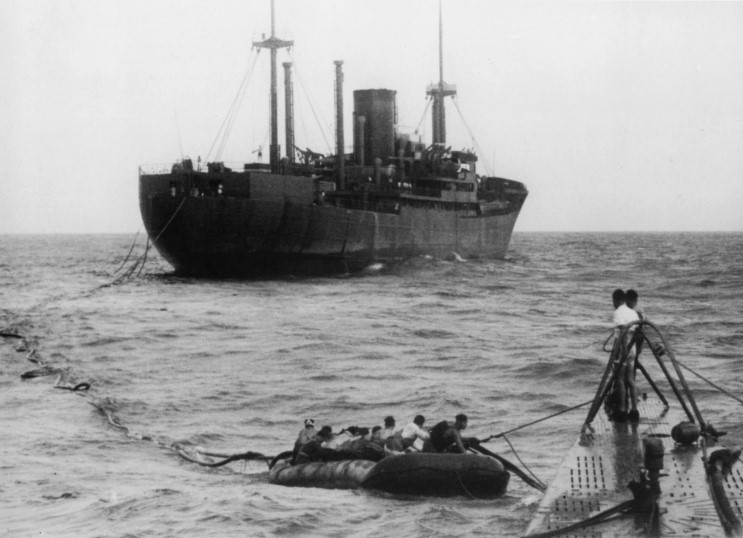The wreckage of the German Raider HSK Kormoran was found by the search team on board the SV Geosounder at 17:30 (AWDT) on March 12th, 2008 in the approximate position 26° 05' 49.4" S 111° 04' 27.5" E . With Kormoran's sinking position established, and the identity of its wreckage confirmed on the basis of high quality sonar imagery, the search for HMAS Sydney (II) has been localised to a most probable area and this search is currently ongoing.
Kormoran's wreckage consists mainly of several pieces of hull amidst a large and dense field of debris, which is indicative of a ship that has suffered a catastrophic explosion. Following the initial discovery of the wreckage field using the 6 kilometre swathe of the SM30 sonar, a series of higher resolution sonar images were made that revealed additional information to confirm the identity of the wreck and its condition, as summarised below:
The wreckage of Kormoran was first found on Line #09 in the northeast quadrant of the designated 1,768 nm² search box. Line #09 was the fourth search trackline to be run and the SM30 sonar had been deployed for approximately 64 hours in the search box (excluding the time for turns) when the wreckage was first discovered. The depth of the site is approximately 2,560 metres.
The wreckage fits perfectly with what we know and expected to see for Kormoran from testimony of the German survivors. The vessel suffered a catastrophic explosion after its cache of some 320 mines stored in the after cargo holds 4, 5 and 6 detonated. This section of the vessel's hull has been obliterated.
There are 4 large pieces of hull structure remaining. The two largest pieces are located hundreds of metres outside the main debris field and approximately 1,200 metres from each other on a line running roughly north-south. The distant locations of these pieces indicate that they sank after the explosion and/or took different glide planes in their descent to the seabed.
The largest piece of hull measures approximately 106 metres long by at least 20 metres wide and has been identified as the forward half of the ship that extends roughly from the engine room to the stem. It is sitting upright on the seabed with a height of approximately 13 metres. The high resolution sonar lines made in this area were focused on this piece because it offered the greatest chance to confirm the wreck as Kormoran by using the acoustic shadows "thrown" by the bow's shape to see if it matched Kormoran's bow.
In addition to matching the known breadth of Kormoran, which was significantly greater than Sydney's breadth, the piece was revealed to have a raised forecastle deck like Kormoran. The forward part of the bridge superstructure was intact at roughly the correct distance from the stem. Lastly, the sonar imagery indicates an opening in the deck in approximately the correct position for the forward cargo hold.
The other large pieces of hull were not able to be identified. However, based on their dimensions and position relative to the blast, it is possible that these pieces are the stern/poop deck and at least part of the engine room/hull structure aft of the main bridge superstructure.
Scene of Engagement between Kormoran & Sydney Found
On line #09, less than 4 nautical miles south of the Kormoran wreckage position a separate and distinct debris field was found at 19:16 (AWDT) on March 12th, 2008. This debris was found to be widely scattered over a distance covering 1,700 metres and lying at a depth of 2,740 metres. However, it was not associated with any major shipwreck targets and was very sparse compared with the dense debris field found at the centre of Kormoran's wreck location.
As Kormoran left the battle intact and was known to have drifted north with the prevailing current and winds after losing engine power, it is logical to conclude that this debris could not have come from Kormoran. However, the location of this wreckage in relation to the known movements of Kormoran in the final stages of the battle and her estimated leeway drift before sinking, does indicate that it marks the actual scene of action between Kormoran and Sydney.
This debris, therefore, must have come from Sydney as we know she had been gravely damaged by a torpedo hit and was being heavily shelled by Kormoran and in such a situation would have been losing pieces of structure and other parts of the ship overboard as was vividly described by the German eyewitnesses. Finally, the approximate NNE - SSW trend of this debris trail fits with the course of Sydney as she altered course south to avoid Kormoran's fire.
Revised Planned Search Area for Sydney
Confirmation of Kormoran's sinking position, as well as the location of the action between Kormoran and Sydney, has allowed me to refine the most probable sinking position of Sydney and outline a new search area for her wreck. This search for Sydney is currently ongoing.
Compared with the extremely large search area for Kormoran the initial search area for Sydney is relatively small and covers several hundred square nautical miles. Key to this initial search area are certain assumptions made about how far Sydney could have travelled away from the scene of action given the grave damage she had suffered - now proven by the extent and size of her wreckage found at the scene of action - and how long she could have remained afloat in such extreme condition.
Based upon the location of Kormoran, and the high quality sonar imagery that is being collected by the Williamson and Associates sonar team, I am confident that if the wreck of Sydney lies within our search area we will find her. Should this initial search area prove unsuccessful, the search area will be enlarged until the wreck of Sydney is found.
